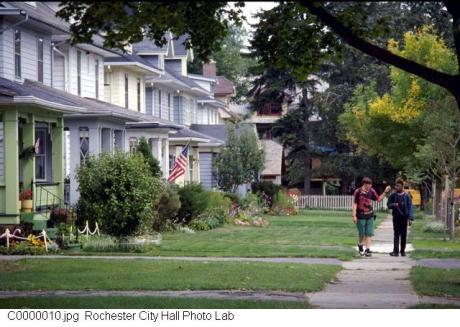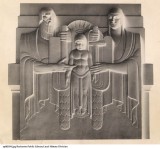As we have seen, cemeteries can be clues to the history of lost communities. What was true of King’s/Hanford’s Landing is also true of the 19th century cemetery officially called The Rapids Cemetery, but more commonly known as the Congress Avenue Cemetery (established 1810). The cemetery leads us into the history of another forgotten settlement that now comprises the 19th Ward and portions of the 3rd Ward (“Corn Hill”) of the City of Rochester.

The Rapids Cemetery, Congress Avenue near Genesee Street
The community’s existence preceded that of Rochester. In 1790, James Wadsworth purchased 2,000 acres from Oliver Phelps and Nathaniel Gorham for 80 cents an acre. A few years later, he purchased an additional 4,000 acres for 50 cents an acre. Wadsworth’s real estate holdings were said to be so vast that he could travel from Geneseo to Rochester without ever leaving his own land.
In reviewing his land holdings, Wadsworth came to the spot that later became the intersection of Brooks and South Plymouth Avenues. He believed the site was ideal for settlement, being located where the Genesee River begins to pick up speed as it rounds the bend heading for the first of several waterfalls in what is now Rochester.
In 1800, Wadsworth built a tavern and store at the site and hired Isaac Castle to manage them. Thereafter the community was officially known at Castletown, but its location by the river gave it the more common, but less grandiose nickname of “The Rapids.”

The Genesee Rapids, near Brooks Avenue (1902)
Wadsworth’s belief in the viability of his settlement was rooted in its location. With few roads in and out of the settlement, aside from a few well-trodden Indian trails, most goods to market had to travel the Genesee and then be transported by land to Lake Ontario, where they could be shipped to other early New York settlements or across the lake to Canada. Wadsworth envisioned Castletown as an ideal fording point from the river to land, bypassing the High, Middle and Lower Falls between the settlement and Lake Ontario.
In its initial decades, “The Rapids” was a transportation hub, with grain, pork, lumber, barrel staves, flour and other goods passing through the community. Shortly after the tavern and store were established, a church, a school and several houses were built, but the growth of the community would be short-lived. In 1822, a feeder canal (located at the present site of the Brooks Avenue bridge) was built to supply Genesee River water to the new Erie Canal. Because of the feeder, boats no longer had to unload at Castletown. They turned off the river and poled up the feeder to the main canal at Rochester (where Mount Hope and South Avenues converge).

The Genesee Rapids, near Brooks Avenue (2008)
The neighborhood fell into an economic slump until 1888 when the Elmwood Avenue Bridge was built and the new Genesee Valley Park opened. The summer recreation opportunities the park afforded made The Rapids neighborhood a desirable residential area. It is in this period the present 19th Ward we know took shape. Properties were subdivided, streets were laid out and homes were built. In 1902, the settlement (which at that point was part of the town of Gates) was annexed by the City of Rochester. The neighborhood was no longer the rough settlement filled with “laborers, teamsters, and boatmen … given to gossip, intemperance and contention” (as it was described in one contemporary description), but a middle-class neighborhood of Rochester, whose residents then as now travel the old Indian trails (now widened, paved and known as Brooks Avenue, Genesee Street, Plymouth Avenue, and Scottsville Road).

Melrose Street in the 19th Ward, ca 1994.
-Christopher Brennan

[…] work at this 200-year-old pioneer cemetery on Congress Avenue is a joint project with the City of Rochester, local veterans organizations, […]